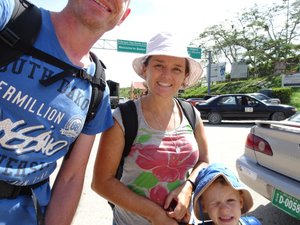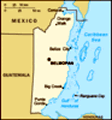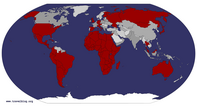Advertisement
Published: January 7th 2017

 Crossing the border
Crossing the border
Quiet pleasant. No queues and we were through in 15 minutes. Take that Sydney airport immigration queuesHands up if you heard of Belize and know anything about it? Ok looks like you are in the same boat as we were in.
Belize is the small country that we had to travel through to get from Guatemala to Mexico. And small it is. It has the second smallest land mass and the smallest population of all the North American countries. Only about 370,000 people live here, which I guess is about the amount that live in our local council back home.
Up until 1981 Belize was a British colony and it is very different to its Spanish neighbours. The culture is very diverse with everything from Mayas, Brits, Africans, Indians, Chinese, Garfuna and various mixes of the above are represented. Most of them also speak their own language. English is theoretically the official language but mostly it's a wild mix where, for example, a question is asked in Spanish and answered in English. The English that is spoken is also not what the Queen would recognise. It's more what you expect to hear in Jamaica.
Even so it was quite strange coming from speaking Spanish for 3 months to be back to more familiar territory. We even found
meat pies here (the size of a party pie). Dillon was in heaven!
We had no expectations of this country so let's see what it had in stock.
San Ignacio
Our first stop was just 10km after the border crossing so we still heard a lot of Spanish. The main attraction here are the ATM caves but more about them later.
The visit to Belize started "well". I stubbed my big toe and took pretty much all of the skin off the tip.
So Kellie went to the caves first and Dillon and I had a day to ourselves. There are not many attractions in town so we went to the "Iguana protection project". Iguanas are also known as bush chickens in these parts. Guess they are just too tasty and easy to catch. Hence the Iguana protection project. The aim is to breed Iguanas to be released and to educate the locals to not put them into their pots.
The visit also includes a stroll in the local forest where we discovered more uses for the local fauna. The sap from one tree in the vicinity could induce unimaginable pain. Luckily leaves from another tree can be used
to counter the effect. We also had our second stab at eating termites. This time they had a nutty flavour. Doubt they will take off as snacks though.
Iguanas are strange, even fierce looking creatures and the males have spikes on their back. Luckily they are vegetarians and don't harm humans. The freshly hatched iguanas are a bright green colour which changes to orange and brown when they get older (good camouflage for the tops of coconut trees). We had fun letting them crawl over us and feed them. Dillon liked it that much that he came back with Kellie the next day.
Next stop were the local Mayan ruins. Nothing too spectacular but nice nevertheless and only a kilometre from town. We climbed onto the small pyramid and explored the buildings. As they are not a major attraction we had them basically to ourselves.
Then it was time to head back and get some dinner.
And dinner we had. We ordered the whole menu. Ok that sounds more impressive than it was. We ate at a local street food stand and they had 5 items to choose from. Was super delicious though. We had tacos, burritos, tortillas and

 Human sacrifice
Human sacrifice
14 year old boy. Skeleton is encrusted with mineralstamales all washed down with orange juice and Horchata. Horchata is a drink made from rice and is becoming Dillon's favourite. Afterwards we were stuffed and had to spend the stately sum of 8 dollars to pay for it.
Actun Tunichil Muknal cave
Actun Tunichil Muknal cave. Try saying that 3 times quick. No wonder everyone shortens it to ATM.
The cave is about 5km long with a river flowing through it. The main attraction is however that they were used by the Mayans for ceremonies and human sacrifice but more of that later.
The cave entrance itself is a spectacular hour glass shaped hole. We donned our life vest and put on our head torch and straight away we had to jump into the cold water. We followed the stream for about an hour coming past impressive stalagmite formations and caverns. Most of the time the cave was 2 to 4 metre wide but there were sections where which were much narrower through to rock falls. One was a tiny passage with a slim opening where hat you had to turn your head in a specific way squeeze through.
One we reached our goal we had to
climb up 3 metres to reach another cave system. This part of the cave is higher up, is mostly dry and is where all the Mayan artefacts are.
The theory is that Mayans came here during the long drought which in the end resulted in the collapse of the Mayan civilisation. They wanted to appease the gods which lived, according to them, under the earth. What better way to visit the gods than to get underground yourself. The cave itself is huge. Easily 20m high and 40-50m wide with huge stalactite and stalagmites.
The place its strewn with pottery that was used in the ceremonies. The ceremonies mostly involved burning incense and afterwards the pots used were broken as they now belonged to the gods. They are still in the same place today.
It is really astonishing to see all these pots in their original location as they were left over 1000 years ago. During very heavy rain some rainwater seeps into the cave and creates a small stream. The Mayans mostly placed the pots into places where this stream flows as they believed that the rain god would be there. Over the last thousand years the minerals in the
water deposited themselves over the pots and encrusted them and they now are covered in white minerals.
Human sacrifice was the ultimate attempt by the Mayans as an offering to bring rain. We saw quite a few skulls and bones amongst the pottery and right at the end of the cave is a famous fully intact skeleton of a 14 year old boy.
Incredible to think that someone came here over 1000 years ago knowing they would die. The way here must have been scary as it is (obviously) pitch black and they only had torches. We got out alive and well.
Caye Caulker
On we went for more R&R.
Caye Caulker is a small Carribean island with a very laid back vibe.
Arriving by boat is stunning. White beaches, blue water, palm trees and behind that a small town. There are no cars on Caye, only bikes and golf carts driven on sandy roads. The whole thing is quite touristy but in a nice way.
We found a waterfront hotel (across the sand road) with pool and settled in. Understandably we didn't do much the first day, apart from a walk around the touristy part of town, which
didn't take too long. We had some belizian specially called 'Fry jack's for lunch, which is a half moon shaped deep fried piece of donut batter cut open and filled with whatever you want (as long as it's beef, chicken, egg or beans).
After that we ventured to "the split" which is the imaginatively named channel that was ripped through the island during a hurricane quite a few years ago. Now it's the place for a cool outdoor dancing bar (Dillon got quite into it).
We had dinner in style at a local restaurant and are barbequed lobster which was large and very tasty.
The next day we went, with the rather curiously named but after you saw the owner somewhat logically named "caveman tours", doing a snorkeling trip. We didn't know if Dillon would like the open ocean but he is full of surprises. He not only liked it, he was an expert in snorkeling at the end of the trip.
Caye caulker is close to the longest barrier reef in the northern hemisphere and we had a brilliant day out. The first stop was in the marine park where we immediately saw a huge turtle, stingrays and even
a 2m nurse shark.
Granted it wasn't surprising to see them as they swam around a fishing boat, which every day cleans the catch here. All the fish were here waiting for a feed. Great start to Dillons snorkeling career anyway.
The second stop was at shark alley. Yet again the sharks were there for some food but nice to see them close up. Apart from all that there are colourful corals and loads of tropical fish. We were even promised a sunken ship which turned out to be a sunken barge covered in coral and home to plenty of colourful fish. The barge capsized in a hurricane 20 odd years ago.
It was all rounded off with loads of seahorses and tarpon feeding. Tarpons are very fast predatorial fish that can be up to 2.5m long. Luckily ours were under a metre as we fed them by dangling a small fish 20 or 30 cm above the water. The tarpons jump out of the water, at the moment when you least expect it, to grab the fish right out of your hand. Luckily they do not have teeth.
That's all folks
It was a quick one week stop
in Belize but I have to say it was better than expected. That wasn't really hard as we didn't have any excitations. So let's say it was really good. The ATM caves really have been a highlight of the trip and Caye Caulker was very nice as well.
Now it's off to our last destination Mexico (as far as Dillon knows but more of that later) .
Advertisement
Tot: 0.266s; Tpl: 0.014s; cc: 15; qc: 72; dbt: 0.1356s; 1; m:domysql w:travelblog (10.17.0.13); sld: 1;
; mem: 1.2mb






















